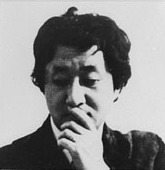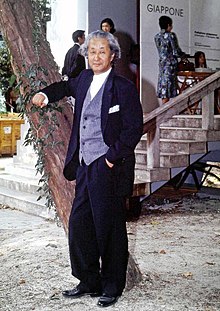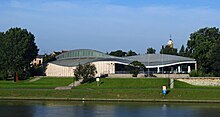Arata Isozaki
Arata Isozaki ( Japanese 磯 崎 新 , Isozaki Arata ; born July 23, 1931 in Ōita , Ōita prefecture , Japan ) is a Japanese architect of international standing. He was awarded the Pritzker Prize in 2019 .
Life
Arata Isozaki was born in 1931 in Ōita, a city in southern Japan. He was the oldest of four children. His father ran a successful transport company. In 1953, Isozaki began studying architecture at Tokyo University , where he attended the class of Kenzō Tange . He completed his studies with a doctorate in 1961 and stayed in Tange's office until 1963. He then opened his own office in Tokyo . In 1964 he gave a lecture for the first time at the engineering faculty of the University of Tokyo. Since then he has given many guest lectures at renowned universities such as Harvard University , Yale and UCLA . He has been married three times and has two sons with his second wife.
Since 1983 he has been an honorary member of the Association of German Architects BDA. In 1987 he received the Asahi Prize for his work in architecture and contemporary culture and in 1990 the Chicago Architecture Prize. In 1998 he was accepted as an honorary member of the American Academy of Arts and Letters . In 2019 he was awarded the Pritzker Prize . Isozaki is an external member of the Polish Academy of Learning (PAU) in Krakow .
Isozaki was originally a major proponent of metabolism , then he remembered geometry as the original mother of Japanese design, and a little later he discovered Claude-Nicolas Ledoux and Karl Friedrich Schinkel as role models. His originally simple geometric compositions, such as the golf club in Oita and the art museum in Gunma, were followed by mannerist postmodern buildings. The connections of his third wife, who was a sculptor, to prominent names in modern art, such as Hans Richter , Man Ray or Friedrich Kiesler, influenced him as much as his earlier dealings with the Tokyo neo-Dadaists . In his formal language he takes up ideas such as postmodernism or the Vienna Secession and processes them into his own style. What is striking is his thoughtful use of simple geometric shapes and the play with shadow and light. Isozaki's current projects must be seen as a successful synthesis of his forty years of work: Picturesque works of art from Japan, influenced by the West.
Buildings (selection)
- 1974: Kitakyūshū Municipal Museum of Art
- 1986: Museum of Contemporary Art, Los Angeles
- 1990: Palau Sant Jordi , Barcelona
- 1994: Tomb of the composer Luigi Nono on the cemetery island of San Michele in Venice
- 1996: Sports complex in Palafolls , Province of Barcelona
- 1998: Building of the Berliner Volksbank at Potsdamer Platz in Berlin
- 2000: Thessaloniki Philharmonic in Greece
- 2005: Torino Palasport Olimpico in Turin
- 2007: Shenzhen Cultural Center Concert Hall , Shenzhen , People's Republic of China
- 2014: Allianz Tower (Il thirdo) , CityLife , Milan
Concert building in Kyoto in the Sakyō district
Art Tower Mito (1986-90)
Allianz Tower (Il thirdo) , Milan (2004 - 2014), in the foreground residential complex by Zaha Hadid Architects
Publications
- with others: Katsura Imperial Villa. Phaidon, London 2011, ISBN 978-0-7148-6254-5 .
- Worlds and opposing worlds. Essays on architecture. Edited and translated from Japanese by Yoco Fukuda; Transcript Verlag, Bielefeld 2011, ISBN 978-3-8376-1116-8 .
- Virginia Ponciroli (Ed.): Katsura Imperial Villa . Electa Architecture, Milano 2005, ISBN 1-904313-37-X .
- Katsura Villa - Space and Form . Photos by Yasuhiro Ishimoto . Rizzoli, New York City 1987, ISBN 0-8478-0783-5 .
controversy
In November 2014, Isozaki attacked Zaha Hadid's winning design for the new national stadium for the 2020 Tokyo Olympics . In a lengthy press release, he sharply condemned the planned construction, claiming that it would be "a shame for future generations". Isozaki was a representative of a number of Japanese architects who vehemently opposed Hadid's design. Even a lighter and cheaper version found no favor before his eyes.
Hadid's comment on this concerted resistance was limited to her reference that all of them were architects who were successful internationally but who did not tolerate international architects in their country. Pritzker Prize carrier Richard Rogers defended Hadid over the accusations, Japan had lost his nerve and leaving it as a leading architect of the world down in favor of a stage of lower quality. Japan's credibility has been damaged.
Web links
- Literature by and about Arata Isozaki in the catalog of the German National Library
- Arata Isozaki & associates
- Arata Isozaki. In: arch INFORM .
photos
- arata isozaki: 10 landmark projects by the 2019 pritzker laureate. In: designboom.com , March 5, 2019.
- Photo book Katsura Imperial Villa (2011). ( Memento from July 22, 2011 in the Internet Archive ). In: Phaidon Verlag
Individual evidence
- ↑ Honorary Members: Arata Isozaki. American Academy of Arts and Letters, accessed March 12, 2019 .
- ↑ The Japanese Arata Isozaki receives this year's Pritzker Prize. In: Deutschlandfunk , March 5, 2019.
- ^ Members of the PAU - Section VI: Art. In: Polska Akademia Umiejętności , accessed March 8, 2019, (Polish).
- ^ Klaus Englert: Postwar Architecture in Japan. Rem Koolhaas, Hans Ulrich Obrist: "Project Japan", Taschen Verlag. In: Deutschlandfunk , March 26, 2012.
- ↑ Photos: CityLife Milano Residential Complex 2004 - 2014. In: Zaha Hadid Architects , accessed March 8, 2019.
- ↑ Amy Frearson: Zaha Hadid's Tokyo stadium will be "a disgrace to future generations" says Arata Isozaki. In: dezeen , November 10, 2014, (English).
- ^ Dan Howarth: Zaha Hadid says Tokyo stadium criticism is "embarrassing" for Japanese architects. In: dezeen , December 14, 2014: "They don't want a foreigner to build in Tokyo for a national stadium. On the other hand, they all have work abroad. Whether it's Sejima , Toyo Ito , or Maki or Isozaki or Kengo Kuma . "
- ↑ Dan Howarth: Richard Rogers steps in to defend Zaha Hadid's scrapped Tokyo 2020 Olympic stadium. In: dezeen , August 13, 2015.
| personal data | |
|---|---|
| SURNAME | Isozaki, Arata |
| ALTERNATIVE NAMES | 磯 崎 新 (Japanese) |
| BRIEF DESCRIPTION | Japanese architect |
| DATE OF BIRTH | July 23, 1931 |
| PLACE OF BIRTH | Ōita |







